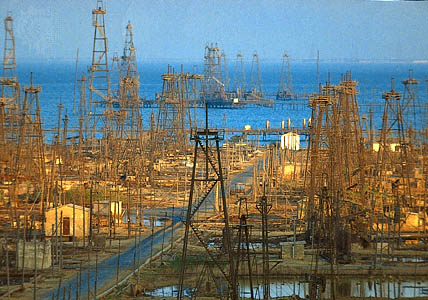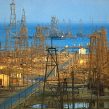
Interest Surging in Azerbaijani Gas (Part Two)
Publication: Eurasia Daily Monitor Volume: 7 Issue: 128
By:

International demand for Azeri gas (EDM, July 1) is also rising outside the European Union. It is mostly driven by the anticipation of post-crisis industrial recovery and by considerations of supply security through diversification.
Russia’s Gazprom is preparing in its own way for Europe’s post-crisis recovery. To protect its market share amid rebounding demand in Europe and stagnant production in Russia, Gazprom seeks, first, to increase Caspian gas imports into
Russia, for re-export or swaps; and, second, to undercut the same countries’ own projects for gas export to Europe. In this context, Gazprom CEO, Aleksei Miller, told the company shareholders’ annual general meeting (AGM) that Gazprom is keen to buy up any available volumes of Azeri gas, without an upper limit, at European netback prices (Interfax, www.news.az, June 25, 29).
Gazprom evidently hopes for delays to the Nabucco and other EU-backed Southern Corridor projects, so as to divert a portion of Azerbaijan’s gas exports northward to Russia. The June 2009 agreement, stipulating a minimum of 500 million cubic meters in Azeri gas deliveries to Russia annually, without a quantitative limit, had marked a first move towards that goal. Meanwhile, however, Azerbaijan has achieved a wide diversification of its gas export options, with Gazprom now facing multiple competitors for Azerbaijan’s current and projected export volumes. Gazprom’s remaining chance to thwart Nabucco would be to buy its way into the Shah Deniz consortium, in the hypothetical event that a stricken BP is forced to sell its stake there. Responding to speculation along these lines during Gazprom’s AGM, Miller stated that Gazprom had not received any such proposals, but would be prepared to consider this possibility.
To dent Gazprom’s monopoly on supplies to Ukraine, that country’s Energy Minister, Yuriy Boyko, proposes to import liquefied natural gas (LNG) from Azerbaijan, via Georgia and the Black Sea to the Ukrainian coast. Boyko’s proposal follows the model of the Azerbaijan-Georgia-Romania (AGRI) concept for moving Azeri gas by pipeline to Georgia for liquefaction, to be shipped as LNG by tankers across the Black Sea, and re-gasified at destination. Boyko proposes to associate Ukraine with the AGRI group for construction of a liquefaction terminal on the Georgian coast at Kulevi, with a counterpart Ukrainian re-gasification terminal near Odessa (whereas Romania envisages its own terminal near Constanta). Boyko proposes Ukrainian imports of 5 billion cubic meters (bcm) annually by this route in the first stage, doubling the volume to 10 bcm in the second stage. He estimates the project’s total cost at $3 billion, including approximately $1 billion for Ukraine, hopes for EU funding of the project, and expects a fast recovery of the investment (UNIAN, Trend, June 14, 19).
On June 29 in Baku, Syrian Oil Minister, Sufian al-Alaw, signed an agreement of intent to import 1.5 bcm of Azeri gas per year during a 20-year period, from 2011 onward. The document follows on a preliminary agreement signed with Azerbaijan’s Industry and Energy Minister, Natig Aliyev, in March in Syria. Deliveries are to reach Syria from Azerbaijan through existing Georgian and Turkish pipelines, and a Turkey-Syria link which is currently under construction (Trend, www.news.az, June 30, July 1; SANA, June 30).
Also in Baku on June 28, Iranian Economy and Finance Minister, Shamsuddin Hossein, proposed starting negotiations on Azeri gas supplies for Iranian petrochemical plants. Hossein estimated the requirement at 5 bcm per year, linked with the Iranian government’s intentions to privatize and overhaul petrochemical plants (Trend, June 28). Azerbaijan had already agreed with Iran in 2009 to export small volumes of gas through existing pipelines for local requirements in northern Iran and possible seasonal storage.
Surging total demand from a growing number of actual and potential customers cannot be met from Azerbaijan’s production only. The country produced 14.8 bcm of gas in 2009 and seems set to approach the 20 bcm mark in annual production by 2015, at which time Shah Deniz production phase one will have reached the plateau level at 8.5 to 9 bcm per year. Shah Deniz production phase two should add some 16 bcm per year after 2017 (Trend, June 19). Meanwhile, Nabucco, the Interconnector Turkey-Greece-Italy, the Trans-Adriatic Pipeline, and White Stream (the four projects within the EU-backed Southern Corridor) all count on Azeri gas, in volumes of 8 bcm to 10 bcm annually for each of these projects.
To meet the total demand from EU and non-EU customers, a “big gas” offer that would add substantial trans-Caspian volumes from Turkmenistan is the optimal solution. This can fulfill Azerbaijan’s long-standing vision to provide transit service, in addition to its own production, as part of a Southern Corridor to Europe. The recent Turkmen decision to connect the country’s eastern gas fields with the Caspian shore by an East-West pipeline can open the way to that “big gas” solution.




